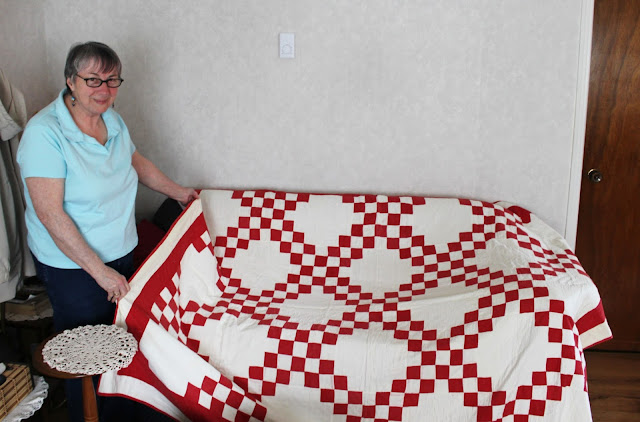On August 3rd, I interviewed Sarah
Griffiths Ennis (born October 20, 1946) of Placentia. When we met, I asked if
she wished to talk about anything in particular. Without missing a beat, she
said, “Recycling. You know, how we recycled, because we didn’t waste anything
then.”
For the most part, we talked about flour
bags, which, as Sarah noted, were “a big thing.” At the time, everyone had a 50
pound sack of flour at home. Sarah explained, “You didn’t buy small amounts,
because everybody had to bake their own bread and make their own cookies.” As a
child, Sarah would venture into the family’s pantry to play with the sack of
flour, discovering that “if you hit both sides of the bag, you’d get a little
puff of flour, because these were cotton sacks. … I thought it was spitting at
me.” She could also mold the sack into “a real good snowman”:
Andrea: So was that while the flour was
in the bag?
Sarah: Yes,
but if it was real full you couldn’t make a snowman, because it was too dense.
So you had to wait until the flour bag was about a quarter gone, or two thirds
gone, or whatever. And then you could push up the flour so you could mold it.
And you could make a little waist around the middle. [laughter]
Once the flour (and the snowman) had been used up,
the flour bag was always repurposed for something else. The cotton of the bag had
a dense weave—it had to be, to contain the flour—and was thus a highly
valuable commodity. As Sarah explained:
Sarah: So
anyway, when the flour bags were empty, they were used for everything. There
was fabric—it was well needed, the fabric was. So it was great. You got the
flour, and you got the cotton. And most women at the time would use them,
embroider them, or make clothes out of them. They were probably used for
shrouds, too. But they were used for school bags, shopping bags, quilts,
blankets—you name it and they used the flour bags for it. Bandages. Slings. And
when we were younger, houses weren’t heated, and we used to wear a lot of vests
inside our clothes. So the vests were often made with flour bags. So then they
would get fancier, and get embroidered. They’d make beautiful things, and the
cotton didn’t wear out, it was good heavy cotton. … And my dad was a sign painter.
So if he was doing signs that were banners, you know, big banners going
across—the flour bags would be used for that. So there was another use for
them, right. Always a use for a flour bag.
As Sarah and her six siblings grew up and
left home, the family’s flour bag supply began to decline. With less people in
the house, less bread was baked and, as a result, fewer flour bags were free
for the taking. Unfortunately, this scarcity also coincided with her mother and
father’s upsurge in “time for creativity.” As Sarah put it, “a silent war” then
began to be waged over the the flour bags. While her mother had visions
of flour bag needlework, her father wanted flour bag sails for his boat. On one
occasion, Sarah was summoned by her father from St. John’s, and asked to sew six
flour bags (which “was a big thing, right, six flour bags”) into sails. Ordinarily,
Sarah’s mother would have undertaken this task, but the two seemed to have
reached an uneasy kind of stalemate. Though her father had won the flour bags,
her mother wasn’t about to help him. A few months later, Sarah and her father
set sail in the flour bag sailboat, and had a close call out to sea. They made
it back to shore in the end, but as Sarah remarked, “I always said, ‘That’s the
flour bags getting even.’”
While Sarah doesn’t have any of the family’s
flour bag creations in her possession, she showed me a flour bag quilt made by
another woman in Placentia:
 |
| Sarah Griffiths Ennis poses with her flour bag quilt. |
It's a little hard to make out, but some labels are still visible on the quilt. The mirror image of this one reads "Goldrim Flour":
 |
| "Goldrim Flour," visible from the back of a flour bag quilt. |
As Sarah summed it up, “this flour bag thing
was so valuable in everybody’s life, everybody in our era.” However, other
kinds of recycling were engaged in as well. In the following audio clip, Sarah
describes how cans of tinned milk and other can lids were reused during her
childhood:



